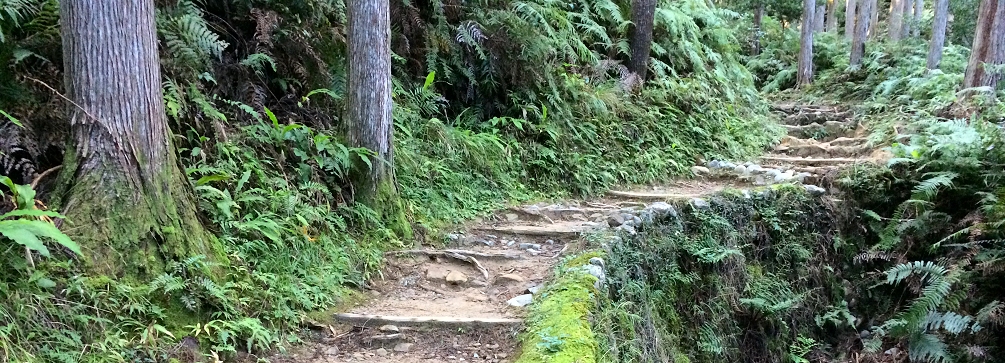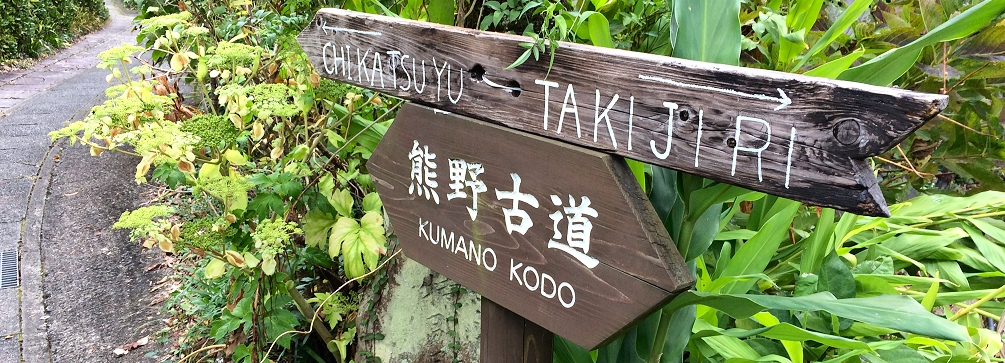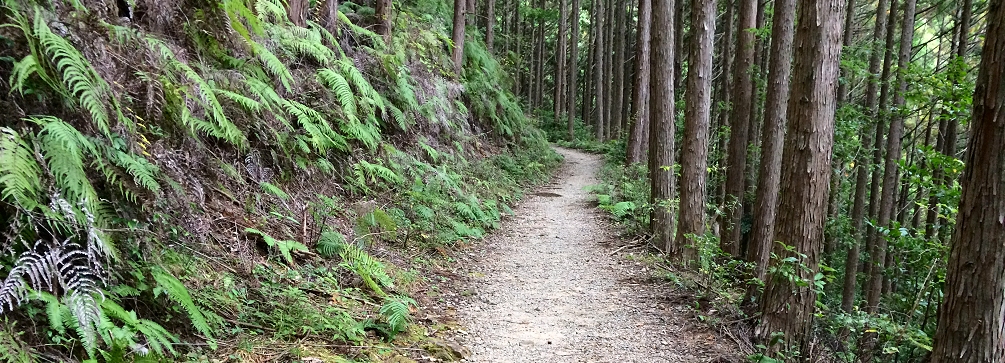Hiking the Kumano Kodo
Pilgrimage Routes in Japan’s Kii Mountains

Kumano Kodo Slide Show for iPad & iPhone

The name Kumano (熊野, literally “bear field”) refers to the southern portion of the Kii Mountains, a remote, rugged and densely forested region long regarded as a sacred dwelling place for kami–the divinities of Japan’s indigenous Shintō religion. The Kumano Kodo (kodo means “ancient path”) is a network of pilgrimage trails that link the three grand shrines of Kumano (Hongu Taisha, Nachi Taisha and Hayatama Taisha) which are together known as the Kumano Sanzan. These shrines (the parent shrines for thousands of Kumano shrines throughout Japan) house, or “enshrine” the local divinities of Kumano. When Buddhism arrived in Japan in the sixth century the belief systems associated with this “new” religion began to slowly meld with those of indigenous Shintō. In time the Shintō divinities of Kumano came to be regarded as manifestations of Buddhist bodhisattvas (enlightened beings who postpone entering the transcendent state of nirvana until all beings are able to attain it). Beginning in the eleventh century, imperial pilgrimages with retinues of hundreds of people set off from Kyoto on a regular basis to visit the grand shrines of the sacred Kumano area. With the establishment of feudal governance in Japan at the opening of the thirteenth century, imperial pilgrimages ceased, but the aristocracy continued the pilgrimage tradition. It was not until the fifteenth century that the Kumano pilgrimage started to become accessible to the general population; the improvement of infrastructure in the region helped to promote the pilgrimage to increasing numbers of people. From the end of the nineteenth century through most of the twentieth, the modernization of Japan led to a decline in the popularity of the Kumano pilgrimage. The last three decades have witnessed a resurgence of interest in the pilgrimage and this was bolstered by the inscription of Kumano’s sacred sites and pilgrimage routes on UNESCO’s World Heritage List in 2004.
On this trip, you will have the opportunity to complete two segments of the Kumano Kodo—the “Kohechi” and the “Nakahechi”—in their entirety. In doing so, you will traverse the bulk of the Kii Mountain range from north to south. For the most part, both the Kohechi and the Nakahechi pass through natural landscapes on well-built trails rather than through settled landscapes making for an extraordinary and enjoyable mountain hiking experience. The Kohechi segment of the Kumano Kodo (also known as the “Shohenro”, or “Koya Kaido”) links Koyasan, the sacred seat of the Shingon Buddhist sect in Japan, with Hongu Taisha. It is a particularly beautiful, less trammeled portion of the Kumano Kodo. The first known pilgrimage along the Kohechi was undertaken in the mid-sixteenth century by Doi Kiyoyoshi, a feudal lord from what is today Ehime prefecture on Shikoku island. Over the years the Kohechi developed into a trading route and was frequently used by pilgrims from the Osaka area who were bound for the Grand Shrines of Kumano. The Nakahechi route which links Hongu Taisha with Nachi Taisha on the east coast of the Kii Peninsula is perhaps the best known segment of the Kumano Kodo. It was a preferred route for pilgrims from Kyoto, the ancient capital of Japan, beginning in the eleventh century. Today, some portions of the Nakahechi are quite popular and well-traveled, but the route still offers ample opportunities to commune with the peace and abundant natural beauty of the Kii Mountains. Join us for this enlightening trail adventure through the heart of sacred Kumano.

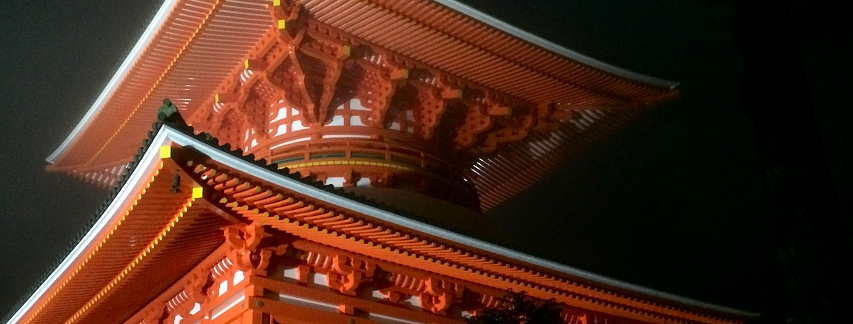
The Konpon Daito pagoda at Koyasan at the beginning of the Kohechi pilgrimage route.
Day 1
Overnight at Koyasan
Lunch and dinner included
Depart Osaka this morning bound for Koyasan, the seat of Shingon Buddhism in Japan, set in a mountain-ringed valley at an elevation of 2,600 feet above sea level. Enjoy a walk beneath towering Japanese cedar trees at Okunoin, the inner sanctum of Koyasan filled with thousands of gravestones of all shapes and sizes. At the Okunoin mausoleum, Kobo Daishi (who brought Shingon Buddhism to Japan and later established its seat at Koyasan in the early ninth century) is said to rest in eternal meditation. Later, explore the grounds of Koyasan’s temple-filled Danjo Garan complex. Its centerpiece is the visually striking Konpon Daito pagoda which is said to represent the center of a lotus flower mandala formed by the eight peaks that surround Koyasan. Tonight, enjoy the experience of spending an evening in temple lodgings (shukubo). Tomorrow, you’ll begin your pilgrimage along the Kumano Kodo bound for Kumano Hongu Taisha, four days away on the beautiful Kohechi segment of the pilgrimage route.

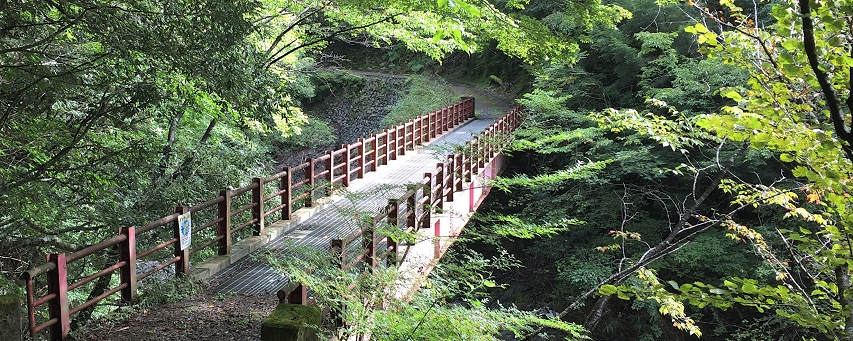
The pilgrimage path crossing the Odogawa below Otaki village.
Day 2
Overnight in Nosegawa
Breakfast, lunch and dinner included
Depart Koyasan on foot heading south over the Rokuro Pass. The pilgrimage path leads through lovely dense forest descending from Rokuro Pass to a crossing of the Odo River (Odogawa). The route then re-ascends to the quiet, secluded mountain village of Otaki where a shelter has been constructed for pilgrims. The path ascends beyond Otaki and makes its way to Mizugamine where the short option hike concludes. For a longer hike continue along the pilgrimage route which eventually descends to the Karawabi River at Omata village. Spend the evening in a nearby riverside hotel and enjoy the peace and quiet of the surrounding mountains.
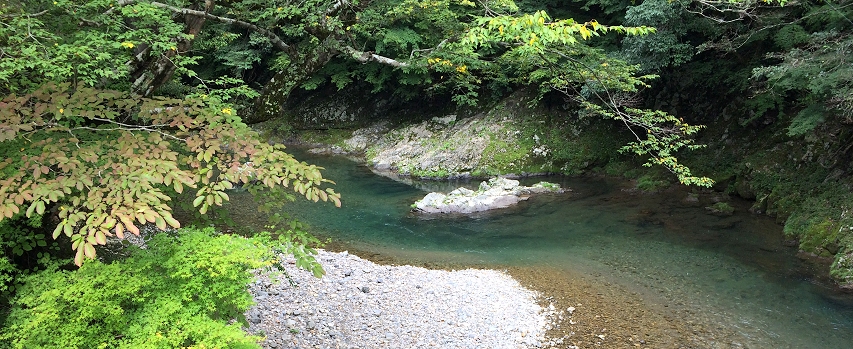
Trail’s end for Day 1 at the Kawarabi River at Omata village.

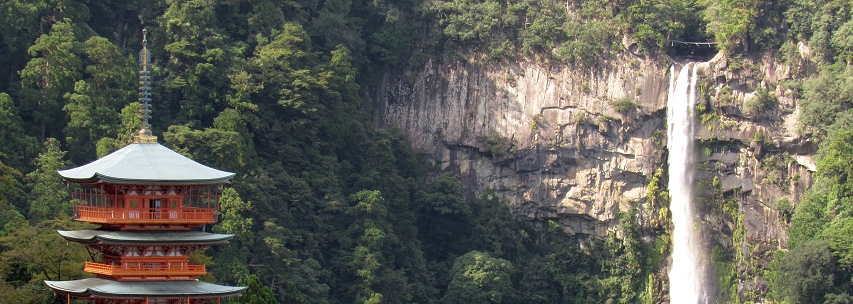
O-taki at Nachi.
What are kami?
Kami are divinities or deities in the Shintō religion and the central object of worship. They are often described as “spirits or forces of nature” that inhabit natural objects. Kami are said to co-exist with humans in the natural world though they are believed to inhabit a complementary realm which remains hidden from the human realm. The eighteenth century Japanese scholar Motoori Norinaga wrote that “any being whatsoever which possesses some eminent quality out of the ordinary, and is awe-inspiring, is called kami” whether good or evil, noble or base. For example, the “awe-inspiring” O-taki (“big waterfall”) at Nachi (the tallest single-drop waterfall in Japan) is considered to be an abode in which a kami (i.e. the spirit, force or essence of the waterfall) resides. In addition, the essence of deceased family ancestors are also considered to be kami. Confused? Discussions about kami and what they are, and aren’t, can be mind-bogglingly complex particularly since the concept of kami has evolved over centuries shifting and adapting to new influences and circumstances.

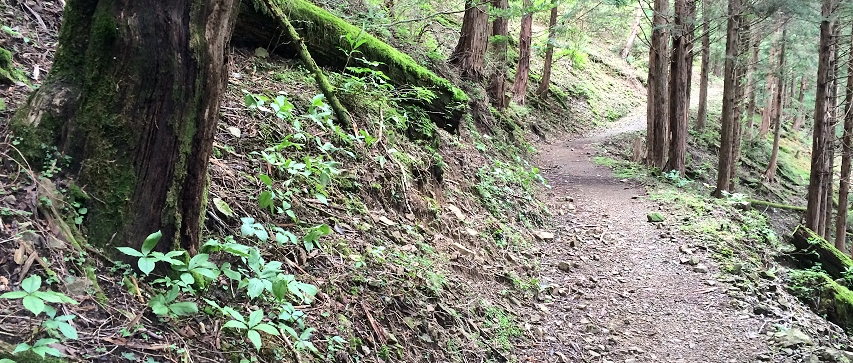
The Kohechi climbing from Omata to Mount Obako.
Day 3
Overnight in Totsukawa
Breakfast, lunch and dinner included
From Omata village, begin the long ascent to the Obako Pass (Obako-toge). The beautifully constructed path ascends in switchbacks through the forest and passes the unstaffed Kayagoya (mountain hut). The ascent continues eventually topping out on the open summit of Mount Obako (Obako-dake). The views from this grassy mountaintop across the jumble of peaks that comprise the Kii Mountains are some of the best mountain vistas along the entire pilgrimage route. After absorbing the views, descend to reach the shelter at the Obako Pass and continue on the long, steady descent to reach the isolated settlements on the valley floor at Miuraguchi. A shorter, less difficult hiking option avoids the long descent to Miuraguchi and instead follows a ridge westward from Mount Obako toward the peak of Kuchisenjo. After the hikes, vehicle transfers bring you to your overnight accommodations at Totsukawa, known for its hot springs (onsen).
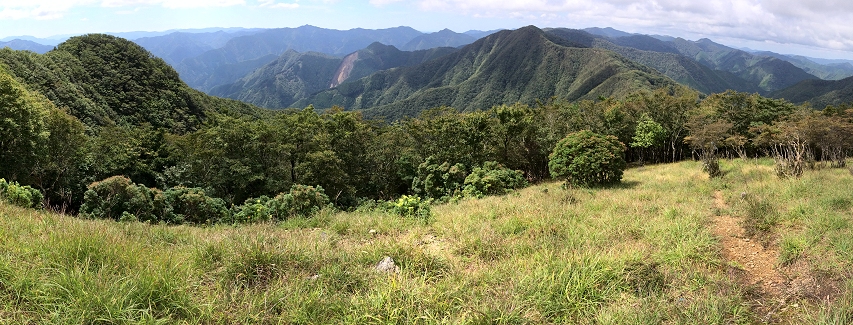
Kii Mountains vista from the summit of Mount Obako.

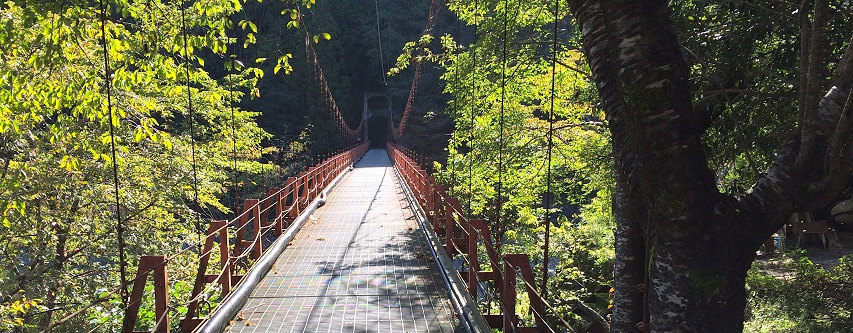
A suspension bridge over the Kanno River at Miuraguchi provides access to the Miura Pass trail.
Day 4
Overnight in Totsukawa
Breakfast, lunch and dinner included
From your lodging at Totsukawa, transfer by vehicle back to Miuraguchi from where you’ll continue your hike on the Kohechi heading south toward Miura Pass (Miura-toge). From Miuraguchi, the trail ascends steadily with the views becoming more expansive as you gain elevation. From Miura Pass, you’ll be able to look back toward the north to see the Obako Pass that you crossed yesterday. The trail then descends to the valley of the Nishi River passing small mountain shrines and the ruins of former habitations now reclaimed by the forest. You can end your hike once you reach the valley floor and shuttle by vehicle to your overnight accommodations at Totsukawa. If you prefer, you can continue your hike by following the narrow and quiet Nishikawa Valley road all the way to Totsukawa.
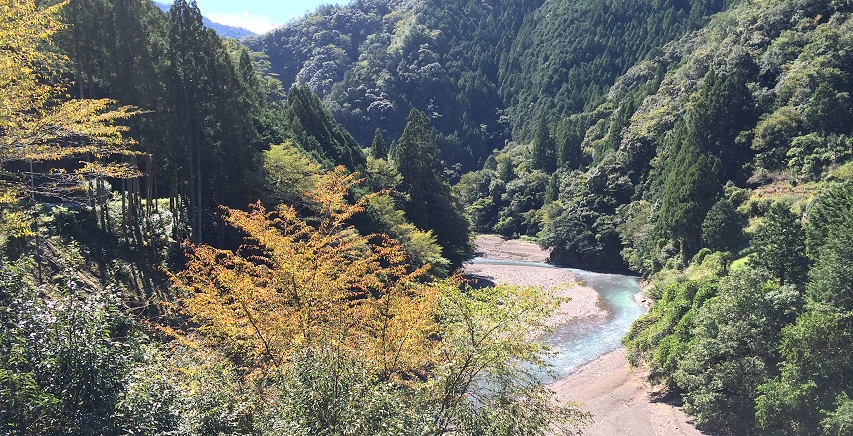
Nishikawa Valley as seen on the hike to Totsukawa.

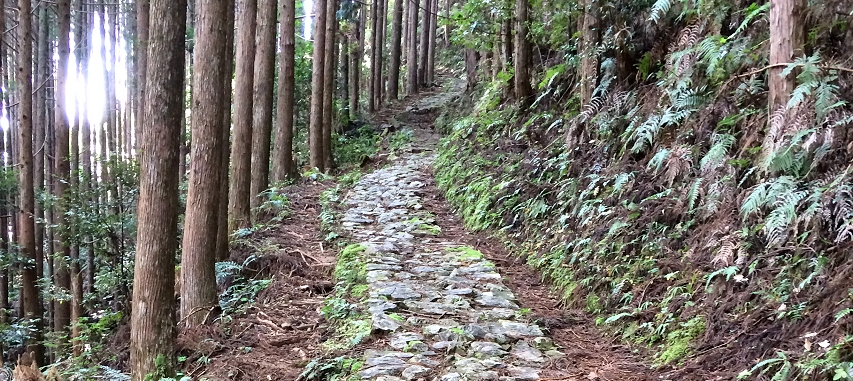
The pilgrimage path ascending to Hatenashi Pass.
Day 5
Overnight at Watarase or Kawayu Onsen
Breakfast, lunch and dinner included
From your lodging at Totsukawa, set off on the day’s hike to the Hongu Shrine (Kumano Hongu Taisha), the first of the three Kumano Grand Shrines that you’ll visit on this trip. On the way to Hongu Taisha, the trail passes through the picturesque mountain village of Hatenashi, then climbs steadily to cross a mountain ridge at Hatenashi Pass. Along this trail, thirty-three statues of the bodhisattva Kannon (often portrayed as female and commonly referred to as the goddess of compassion or mercy) have been placed at intervals alongside the path. You’ll also pass old rice terraces and the ruins of teahouses that once served travelers along the pilgrimage route. From Hatenashi Pass, the trail descends to the main valley of the Kumano River; a short vehicle shuttle from this point will bring you to the Kumano Hongu Taisha. If you prefer, dispense with the vehicle shuttle and walk a short, well-traveled section of the Nakahechi segment of the Kumano Kodo to Hongu Shrine. As you descend this section of the Nakahechi, you will catch your first sight of Hongu Taisha’s enormous temple gate (known as O-torii).
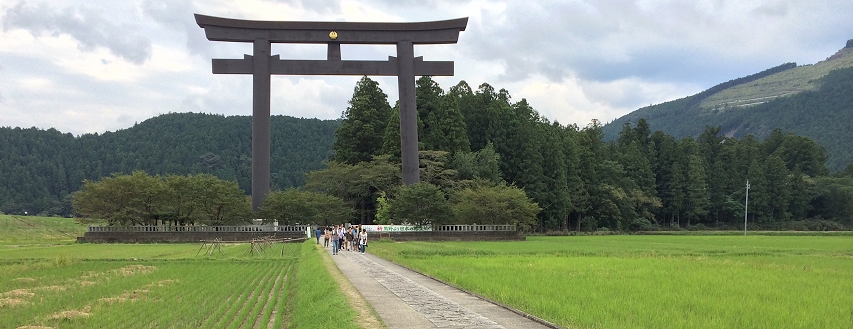
O-torii, the shrine gate at Kumano Hongu Taisha is over a hundred feet tall.


Haraido-oji near Hongu Taisha.
What are oji?
Oji are subsidiary shrines housing the “child gods” of the twelve main Kumano deities who are referred to as gongen in Japanese, or avatar in Sanskrit (meaning “manifestation”). The oji function as way-markers to guide pilgrims along the pilgrimage route while also serving as places for rest and the performance of purification rituals. On Imperial and aristocratic pilgrimages which begin in the eleventh century, activities such as sutra and poetry readings and sumo matches were held at oji sites. There are said to be ninety-nine oji between Kyoto and Nachi Taisha although this expression does not refer to an exact number. Instead it alludes to the existence of a great number of oji along the Kumano pilgrimage routes and along the Nakahechi segment in particular. Five oji are considered of particular importance, two of which you’ll see on this trip. These are Takijiri-oji (at the western entry point into the sacred area of Kumano) which you’ll see on Day 10, and Hosshinmon-oji which you’ll see on the way to Mikoshi Pass on Day 9.

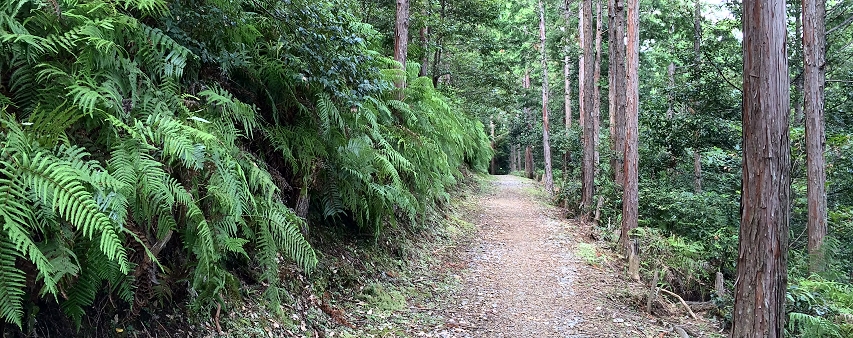
Well-groomed section of the Kogumotori-goe (Nakahechi).
Day 6
Overnight at Watarase or Kawayu Onsen
Breakfast, lunch and dinner included
Today’s hike takes you along the Kogumotori-goe section of the Nakahechi which winds through the mountains between the settlements of Ukegawa and Kowase. Kogumotori-goe means “Small Cloud Gathering Pass.” You’ll pass the remains of at least three “teahouses” that appear in written records as early as the seventeenth century. These teahouses served as places for accommodation and exchange for people on the Kumano Kodo pilgrimage. Most of the teahouses started disappearing by the end of the Meiji Restoration in the early twentieth century. Also on this route is the Hyakken-gura Lookout with its expansive view over the Kumano sanzen roppyaku po (“3,600 Peaks of Kumano”).
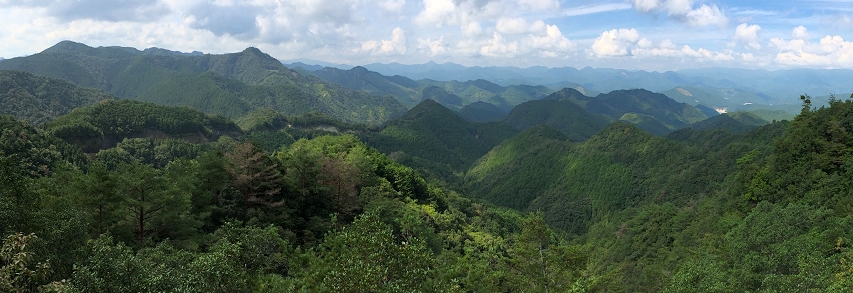
View over the “3600 Peaks of Kumano” from Hyakken-gura lookout on the Kogumotori-goe (Nakahechi).

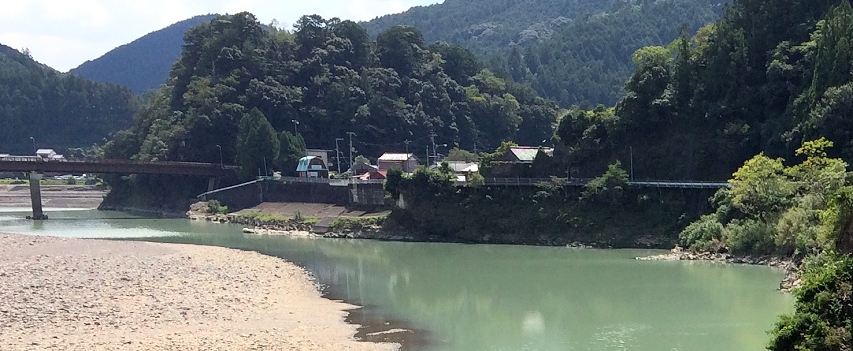
The Kumano River threads its way through sand bars passing small villages on its way to the sea.
Day 7
Overnight in Kii Katsuura
Breakfast, lunch and dinner included
Take a well-earned day of rest from the trail. If you desire, you can enjoy an optional morning hike from Watarase Onsen to Hongu Taisha via the short, but beautiful Dainichi-goe, a variant of the Kumano Kodo. After lunch in Hongu, travel by vehicle to the Kumano River where you’ll board an open boat for a ten-mile journey down the river to Hayatama Taisha (the second of the three Grand Shrines of Kumano). This was the traditional means for Kumano Kodo pilgrims to from Hongu Taisha to Hayatama Taisha. Later, travel by vehicle to the seaside spa town of Kii Katsuura, your base for the next two nights.
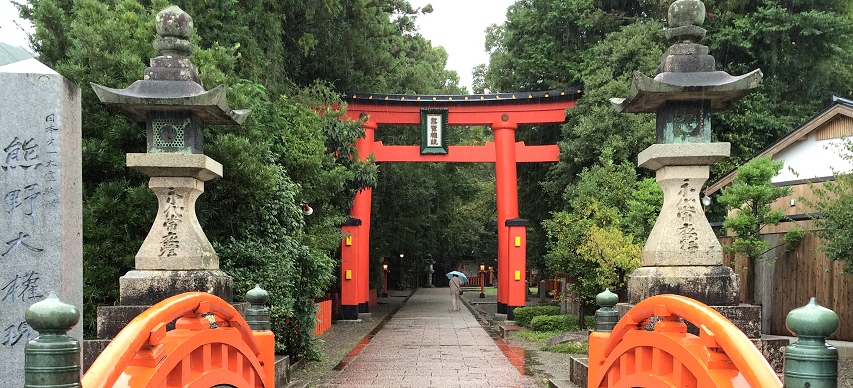
The gate at Hayatama Taisha.

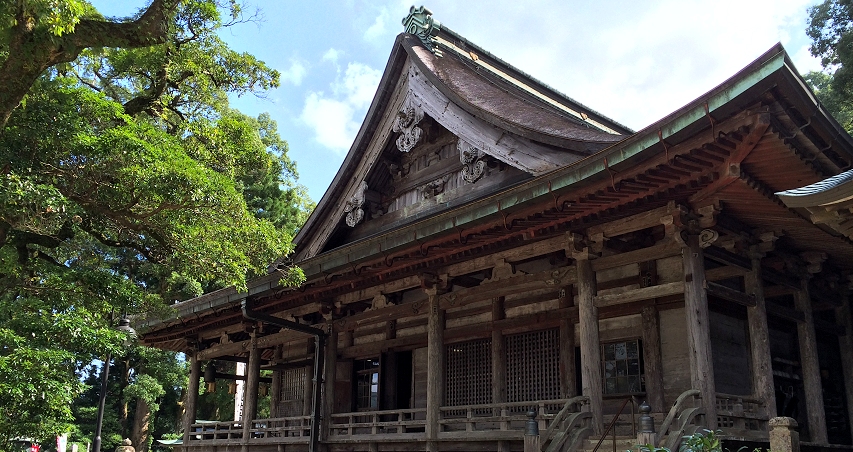
The Buddhist Seiganto-ji at Nachi.
Shinbutsu-shūgō
Shinbutsu-shūgō is the “fusion” of Buddhism and Shintō (the indigenous religion of Japan) which centers around the worship of kami (natural phenomena and the spirits of ancestors). When Buddhism was introduced to Japan in the late sixth century its beliefs were reconciled with those of Shintō and both sets of beliefs were assumed to be true. Buddhism and Shintō have never quite fused, but they remain closely linked. For example, in this melding, the Shinto deities of Kumano are believed to be manifestations of Buddhist bodhisattvas (enlightened beings). Hongu Taisha is associated with Amida (the bodhisattva of compassion), Nachi with Kannon (the bodhisattva of mercy) and Hayatama with Yakushi (the bodhisattva of healing). You will see ample evidence of this melding as you journey along the Kumano Kodo pilgrimage. Another example is the presence of Buddhist temples adjacent to the sacred Kumano shrines.

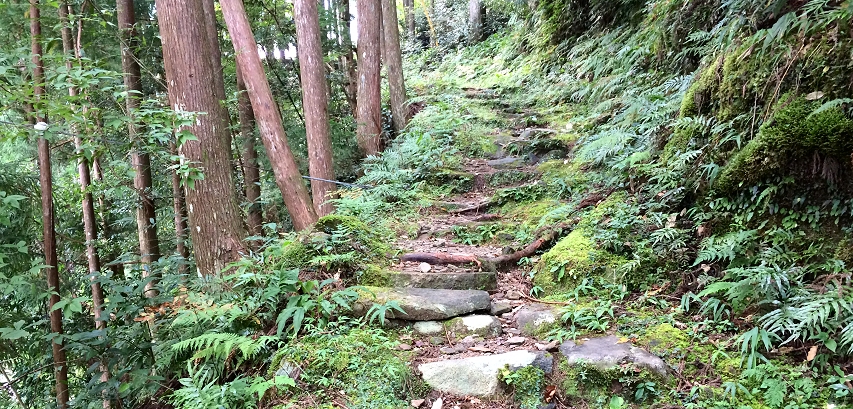
The moss and fern-fringed pilgrimage path on the Ogumotori-goe section of the Nakahechi.
Day 8
Overnight in Kii Katsuura
Breakfast, lunch and dinner included
Set off today for Kumano Nachi Taisha (the third Kumano Grand Shrine that you’ll visit on this tour) following the course of the Ogumotori-goe (“Big Cloud Gathering Pass”) segment of the Nakahechi. From the start of the trail at Koguchi village, the trail ascends to the moss-covered Waroda (“round cushion”) Rock in a luxuriant setting of forest greenery. The three symbols that you see carved on the rock represesent, from left to right, the Buddhist bodhisattvas Kannon (mercy), Yakushi (healing), and Amida (compassion). Waroda Rock is said to be a gathering place for the Kumano deities. Beyond the Waroda Rock the path passes by the remains of the Kusu-no-Kubo hatago (traveler’s inn). There were once many hatago along the Kumano Kodo, and innkeepers would compete with each other to attract customers. (One innkeeper advertised, We have tofu; bath is ready.) The pilgrimage route continues its steady ascent to the Echizen Pass, the highest point on the Nakahechi. There may have been a teahouse here at one time, but today all is quiet except the wind in the trees. The trail descends briefly and makes a crossing of the Ishikura Pass before arriving at the site of the old Jizo teahouse. You can end the hike here, or continue on foot through the mountains crossing the Funami Pass before making the final descent to Kumano Nachi Taisha.
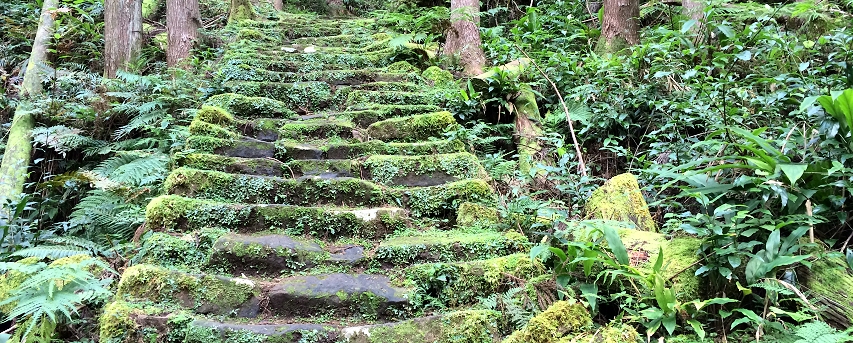
Mossy staircase on the Ogumotori-goe.
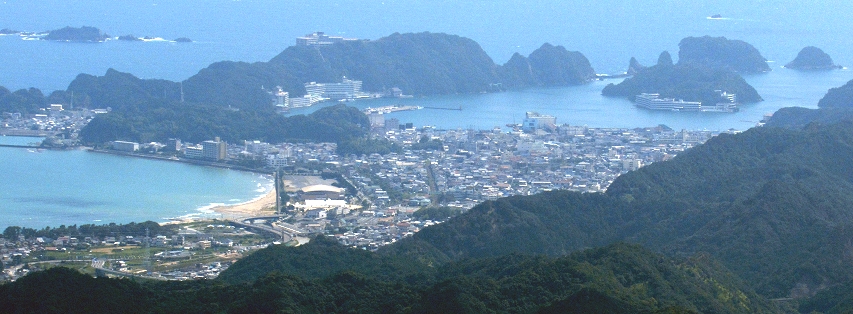
A telephoto view of Kii Katsuura town from near Funami Pass on the Nakahechi.
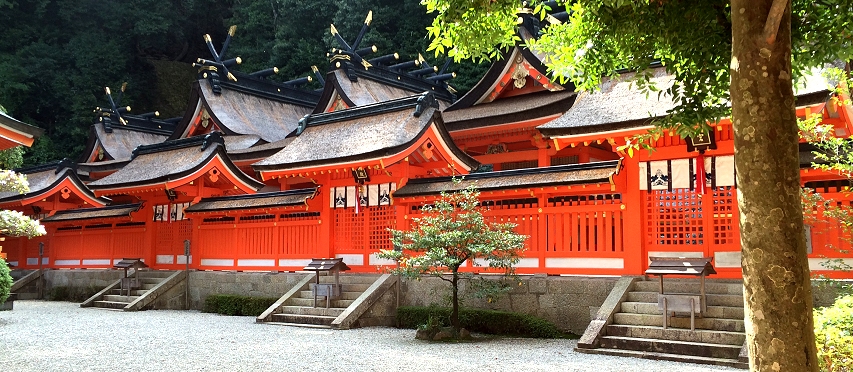
Kumano Nachi Taisha.

Day 9
Overnight at Kawayu or Watarase Onsen
Breakfast, lunch and dinner included
Transfer by vehicle back to the Hongu Taisha area. Over the course of the next two days, you’ll head westward on the Nakahechi toward its traditional starting point at Takiriji-oji. Today’s hike takes you from the ruins of the Sangen teahouse and passes through rural landscapes before following the course of the Otonashi River through forests to the Mikoshi Pass. Beyond Mikoshi Pass, the Nakahechi descends and climbs once again to cross the Waraji (“straw sandal”) Pass. The route then makes its way past small farmsteads to Tsugizakura-oji where the day’s journey ends. On this hike, you’ll pass no fewer than nine oji sites (see note “What are Oji?” above). This, perhaps, testifies to the prestigious status of the Nakahechi as the principal route for aristocratic pilgrimages from Kyoto in days gone by. If you’d like a shorter hiking option, you can begin this hike at Mikoshi Pass and hike from there to Tsugizakura-oji.
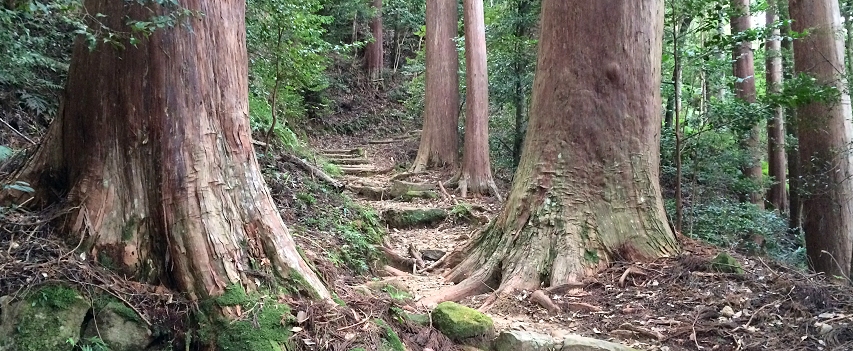
On the Kumano Kodo.

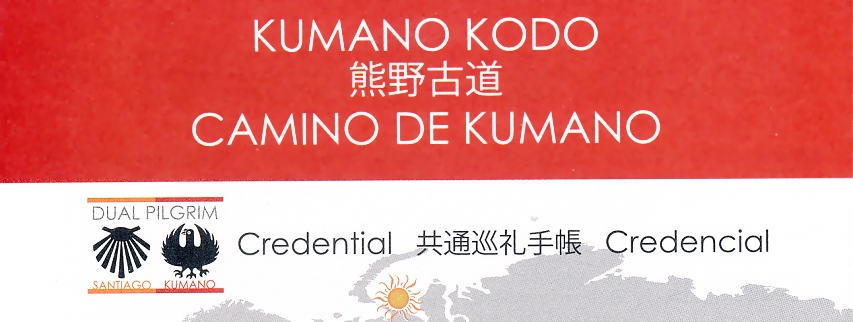
The “dual pilgrim” credential.
Dual Pilgrim
For those who have walked Spain’s Camino de Santiago, it’s interesting to note that the Kumano Kodo pilgrimage has been officially “twinned” with the Camino de Santiago. A “Dual Pilgrim” program is administered the tourism offices in both Tanabe City (for the Kumano Kodo) and in Santiago de Compostela (for the Camino de Santiago). The dual pilgrim “credential” features the logos of both pilgrimage routes–the scallop shell for the Camino de Santiago and the three-legged raven, or Yatagarasu, for the Kumano Kodo. The Camino de Santiago and the Kumano Kodo are the only two pilgrimage routes currently designated as World Heritage Sites by UNESCO.

Day 10
Overnight at Shirahama
Breakfast, lunch and dinner included
Travel by vehicle to Tsugizakura-oji from where you’ll begin your last day of hiking along the Kumano Kodo. From Tsugizakura-oji, the route leads past mountainside farms to the village of Chikatsuyu and the Chikatsuyu-oji set in a grove of trees alongside the Hiki River. The route then ascends through woods to a ridge crest which it follows to the vibrantly colored shrine at the mountain village of Takahara. Takahara village is sometimes referred to as kiri no sato (“mist village”) since fog often blankets the slopes below the settlement. The pilgrimage route leaves Takahara and continues to follow the mountain ridge until its last descent to the Takijiri-oji, the western entrance to the sacred area of Kumano. Transfer by vehicle to your seaside accommodations at Shirahama with its gorgeous white sand beach. A farewell dinner caps off your Kumano Kodo hiking adventure.
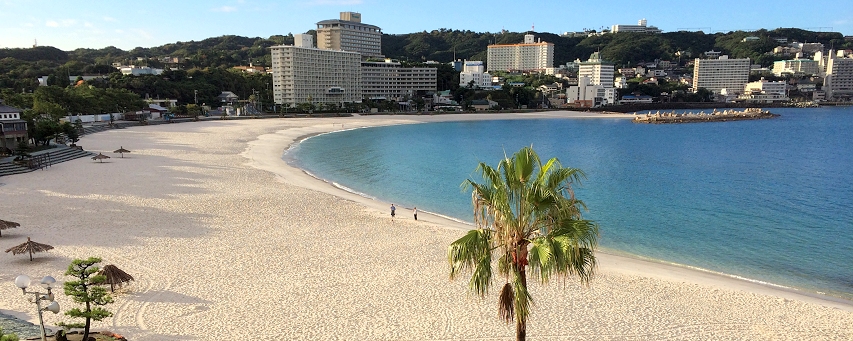
The white sand beach at Shirahama, a great venue for “moon viewing.”

Departure day
Breakfast included
This morning after breakfast, transfer on your own from the Shirahama bus center to Kansai International Airport. Your guides will be pleased to help you make the appropriate arrangements.

Pagoda and waterfall at Nachi Taisha.

Other Resources
CNN calls the Kumano Kodo “the world’s best unknown hike.” Read all about it. Enjoy this video about the sights and sounds along the pilgrimage route.

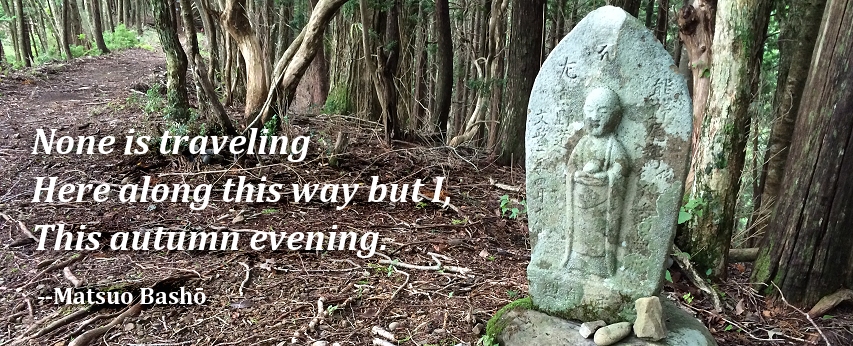
On the trail to Omata village, Kohechi.
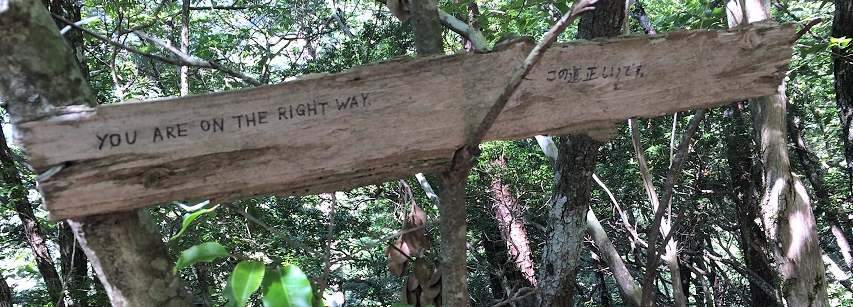
A reassuring sign on the Kumano Kodo.

Kumano Kodo Slide Show for iPad & iPhone


Photos on this page are by John Osaki (© All Rights Reserved) except as otherwise credited.


